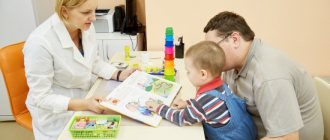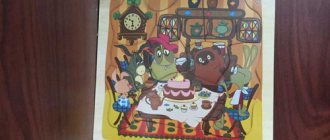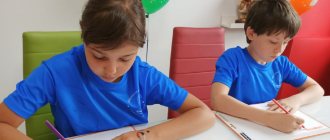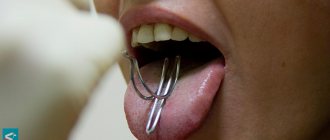Speech disorders in children
All forms of speech-language pathology were initially described by physicians because initial descriptions involve clinical intervention. However, these are isolated studies (S.S. Mnukhin, E.I. Kirichenko, A.N. Kornev). Children with various complaints about speech disorders often first go to the doctor, who then refers them to a speech therapist. Accordingly, all research on speech disorders is in the field of speech therapy.
Unlike adults, children independently and spontaneously master language while being in a full-fledged language environment. This is hard and serious work that requires the use of a wide range of cognitive abilities:
- language and intellectual capabilities;
- planning skills;
- ability to concentrate and switch attention;
- states of articulatory praxis, etc.
All this is necessary to master the language. If cognitive abilities are limited and immature, then it will be difficult for a child to learn to speak independently without the help of a specialist.
Epidemiology
The sooner a problem is identified, the easier it is to cope with it - correctional work and medical and psychological assistance will be more effective. Today, in speech therapy, speech disorders are identified at the age of 5-6 years and later.
There are a lot of children with speech disorders in Russia:
| Russia | English-speaking countries | |
| 5-6 years | 25-30% | 4-5% |
| 7-8 years | 17-20% | 3% |
| Over 8 years old | 1% | 1% |
| Boys/girls | 3:1 | 2:1 |
The table shows the percentage of those children who have speech deficiencies that require specialist intervention. By about 6 years of age, children fully master language skills in terms of pronunciation and grammar. Before this, they are allowed to make certain mistakes, according to their age. However, it is important to understand that each age has its own acceptable and unacceptable speech errors.
If we compare with English-speaking countries, the difference is quite noticeable. This large gap is related to diagnostic criteria, not to the children's abilities. Nevertheless, the number of children with speech disorders is quite large. Most often boys suffer from the pathology.
Causes of dysontogenesis
The nature of the development of speech pathologies is traditional. Reasons include:
- Constitutional (hereditary) forms. It occurs most often; most speech disorders have a hereditary factor.
- Somatogenic forms. A child aged 1-2 years suffered some serious illness for his age. If the disease occurs during a sensitive period for speech, this may affect the full development of speech.
- Cerebral-organic forms. They develop as a result of pathologies during pregnancy or difficult childbirth.
- Deprivation forms. Emotional and communicative deprivation, which in most cases occurs among residents of orphanages and orphanages.
- Forms of mixed genesis. Combine two or more of the above forms.
Disadvantages of pronunciation of individual sounds
| Defective sound | Phonetic defect (sound distortion) | Phonemic defect (confusion, sound replacement) | ||
| Name of pronunciation defect | Types of defective pronunciation | Name of pronunciation defect | Types of substitutions | |
| Sound R | Rotacism | Velar, uvular, lateral, buccal, single-impact, “coachman” | Pararotacism | Р = Р' Р = Л' Р = J Р = Г Р =Д |
| Sound L Sound L' | Lambdacism | Bilabial, softened | Paralambdacism | L = Y L = G L = L' L = R |
| Sounds S, S' Sounds Z, Z' Sound C | Sigmatism | Interdental, labial-dental, lateral, subdental, sibilant | Parasigmatism | S, Z, C = W S, Z, C = F S, Z, C = T S, Z, C = Shch S - W; C = H |
| Sound Ш Sound Ж Sound Ш Sound Ш | Sigmatism | Mesdental, buccal, lateral, “lower”, posterior lingual, softened, shortened, affricative | Parasigmatism | Sh, Zh, Shch = T Sh, Zh, Shch = F Zh = Sh Zh = Z Shch = S' Sh = Shch Ch = T'; Ch = Sh' |
| Sound j | Yotacism | Soft lower and upper articulation | Paraiotacism | J = L' |
| Sounds K, K | Kappacism | Vocal, laryngeal | Paracapacism | K = T |
| Sounds G, G | Gammacism | Fricative velar, pharyngeal | Paragammatism | G = T |
| Sounds X, X | Hitism | Vocal, laryngeal | Parachytism | |
Partial PNR
PND stands for primary speech underdevelopment. Classification of partial PNR:
- Functional dyslalia. These are defects in individual sounds that can be easily eliminated (in a couple of weeks/months).
- Articulatory dyspraxia (dysphonetic, dysphonological and dynamic forms). It represents polymorphic pronunciation disorders that are associated with a violation of cerebral support, i.e. with inferiority at the neurobiological level. Dyspraxia may be accompanied by problems with vocabulary and grammar. Requires longer correction.
- Developmental dysarthria. The causes of dysarthria are pathologies during pregnancy and birth trauma.
- Rhinolalia. These are serious speech disorders that occur due to the incorrect structure of the dentofacial apparatus.
- Dysgrammatism. It manifests itself in selective violation of the rules of grammar, agreement of words by gender, number, cases, etc. Reflects exclusively the grammatical side.
This classification is notable for its clinical focus. That is, it can be used by both speech therapists and doctors.
In addition to partial speech disorders, secondary speech underdevelopment is also distinguished. They are associated with pathologies of physical and mental development (for example, hearing impairment, mental retardation, mental retardation, etc.).
Types of sound reproduction pathologies and clinical manifestations
A child can reproduce any sound incorrectly, but more often children pronounce whistling sounds poorly: ([s], [z], [ts]), hissing sounds ([w], [zh], [ch], [sh']), sonorants ( [p], [l]). These sounds have a complex structure and require sound pronunciation skills. Sound units that are easy to reproduce are less likely to be disrupted. These include − [m], [n], [t], [p]. These sound units appear at an early stage in the formation of speech function.
Types of sound reproduction disorders:
• absence of a sound unit; • sound change; • replacing one sound unit with another; • mixing sound units.
The absence of a sound unit manifests itself in the form of loss of sound in a word. It disappears at the beginning, in the middle or at the end of the word. Example: pocket - kaman, different - azny, Cupid - Amu.
Sound distortion is characterized by an altered pronunciation of a sound unit that does not correspond to the Russian phonetics system. This form of GSD (general speech impairment) includes several types of distortion:
- Change of sound unit [r]: velar or uvular [r].
- Distortion [s]: interdental [s].
- Modified [l]: bilabial [l].
In some patients, speech dysfunction is manifested by the replacement of sounds. Example: compote - tomkot, lip - oak, dusk - fumrak, cracker - fuharik, house - tom, hummocks - gochki, frame - ryama, lamp - lamp. Sound confusion is characterized by the patient confusing sound units with each other. Example: cap - boot, sleigh - shanochki. In this case, the child pronounces and distinguishes the sounds [s] and [sh] separately and correctly.
Types of dyslalia:
- Mechanical (pathologies of the articulatory apparatus, congenital diseases).
- Functional.
- Physiological (norm for patients under 5 years of age).
- Monomorphic sound pronunciation disorder is the incorrect reproduction of sound units belonging to the same group.
- Polymorphic sound pronunciation disorders are errors in the reproduction of more than four sound units belonging to different groups.
Total PNR
With total speech impairment (TSI), there are deficiencies in all areas of the language: phonology, sound pronunciation, grammar and vocabulary. The child's mastery of all language means is generally impaired.
The disorders presented in the classification are classified as severe:
1. Alalic variant (motor and sensory alalia). With motor alalia, a child under 4-7 years of age does not use speech, except for a set of babbling words (for example, woof-woof, co-co, bi-bi). The child cannot fully communicate, which entails serious impairments in communication capabilities. It is relatively rare - 0.5%.
Sensory alalia is an even more severe condition in which the child does not understand spoken speech and does not connect words with meaning. The disease has been little studied and is difficult to diagnose. Correction not started in time (from 2-3 years of age) can cause serious maladaptation and lead to disability.
2. Paraalalic version of THP. The symptoms and signs are similar to motor alalia, but it proceeds much easier and is overcome more quickly (in 2-3 years).
3. Clinical forms with a complex type of disorder (“mixed”).
If by the end of preschool age it is not possible to cope with dysontogenesis, the child is sent to study at a speech school. To achieve noticeable results, correction work must continue for at least 5-6 years. A regular school can only aggravate the child’s condition: serious difficulties will arise in learning, and a lack of oral speech causes deficiencies in written language.
Comorbidity
Total PND is characterized by a high comorbidity rate. 60-70% of children with sound pronunciation disorders have problems with attention, memory and the emotional sphere. 50% of children with dyslexia and 60-80% of children with mental retardation or mental retardation have oral speech disorders.
Speech impairment is quite often accompanied by many disorders:
1. Cognitive deficit:
- random access memory;
- verbal-logical functions (the ability to think categorically using generalizing concepts);
- successive operations;
- finger and articulatory praxis;
- attention (auditory, rarely visual);
- immaturity of gaming competence.
2. Personal sphere:
- surface of social connections;
- immaturity of the emotional-volitional sphere.
3. Communicative competence:
- poor command of dialogue (especially monologue);
- difficulties in establishing partnerships.
The lack of language means limits the possibility of mastering verbal and logical skills in thinking. This can affect the personal sphere, because difficulties arise in communicating with peers and adults. If the child received timely and comprehensive help, the outcome will be more favorable. Comprehensive care means both the participation of a speech therapist and the participation of doctors.
Dysontogenesis is dangerous with negative consequences. The child has difficulties in learning in basic subjects, there is an inferiority of socio-cultural discourse and behavioral disturbances. It is worth talking separately about dyslexia and dysgraphia, since these are the most serious disorders that follow speech impairment.
Correction methods
Once the cause of speech defects is precisely determined, it will be possible to accurately determine the correct treatment path. For example, mechanical dyslalia can only be cured through surgery. The operation will help remove anatomical defects that interfere with the normal functioning of the speech apparatus.
Complex dyslalia in preschool children is treated with:
- articulatory gymnastics;
- development of hearing sensitivity;
- speech therapy massage;
- development of micromotor skills;
- techniques for proper breathing during a conversation.
Speech therapy assistance
After the first visit to a speech therapist, the specialist develops an individual plan of work with each child. Classes should be held at least 2 times a week, and preferably up to 3-4 times, then the result will appear faster. The child’s parents should also help by regularly performing a special set of exercises at home.
Speech correction by a speech therapist takes place in several stages:
- Preparatory. A speech therapist conducts classes that help better develop memory, thinking and attention processes. The child learns to compare and conduct independent analysis. The specialist helps develop phonemic awareness, teaches sound analysis and develops speech breathing. At this stage, the child performs exercises that help him pronounce sounds correctly: with his lips, cheeks, tongue, palate and jaws.
- At the next stage, the specialist teaches the child to speak correctly. The exercises are carried out in a playful way; if necessary, additional speech therapy probes can be used. You can play no more than 2 sounds at the same time.
- Automation of sounds. The child must learn to automate sounds in words, syllables, phrases and texts, and a little later in live speech. To consolidate the results, parents need to repeat the exercises daily at home.
- The final stage. The child must learn to differentiate the new learned sound from the one with which he previously replaced it. This is necessary in order to exclude a recurrence of the disease, so that the burr does not return.
To achieve results and cure polymorphic dyslalia, you need to exercise regularly for six months. As practice shows, a speech therapist can easily cope with the problem, and the child will be able to speak correctly at school.
But parents need to remember that only the harmonious work of adults, a specialist and a positive atmosphere will prevent complications.
Home gymnastics
Parents and children can do simple gymnastics every day at home:
- move your tongue left, right, then clockwise and back, stretch your tongue to your nose and chin;
- fungus exercise - suck your tongue to the roof of your mouth, and then open and close your mouth;
- movement of the lips - up, down, smile, vibrate, stretch into a tube;
- close and open your mouth as wide as possible, stretching the jaw ligaments;
- speak tongue twisters.
Exercises can be performed morning and evening, spending only 5-10 minutes.
Speech therapy massage
This type of massage helps stimulate articulatory muscles, has a relaxing effect, improves blood flow in soft tissues, and trains the muscles that are responsible for the formation of the speech apparatus, causing them to function in a coordinated and correct manner.
Massage has a reflex effect on the entire lymphatic system, improves the passage of lymph through the vessels. The elasticity of muscle fibers, their strength and the volume of contractile function are significantly increased, and their activity is better restored after exercise.
The massage is carried out in a warm, ventilated room. The massage is carried out in cycles of 10, 15 or 20 sessions; it is better to carry out the procedure every other day. After a month's break, you can repeat the procedure.
During the massage, the child can lie on his back with a cushion under his neck, or he can also sit half-sitting in a chair with a high headrest.
It is more effective to use the classic type of massage, which involves light stroking, kneading, rubbing, and vibration. You can perform the massage with your hands, a toothbrush with soft bristles, rubber spatulas and others.
There are also acupressure, hardware and probe types of massage, but they must be carried out by a specialist so as not to cause harm.
Dyslexia through the eyes of a doctor
Dyslexia as an independent disorder was first described at the end of the 19th century by English ophthalmologists. The pathology was defined as word blindness - the child is intellectually developed, but cannot recognize words. In Russia, such cases were first described by R.A. Tkachev and S.S. Mnukhin.
Dyslexia is a specific reading disorder. About 10% of children experience difficulties mastering reading during their school years. Compared to other children, they are not able to learn to read in the proper time. After finishing school, many of them remain semi-literate.
Dyslexia is a condition whose main manifestation is a persistent, selective inability to master the skill of reading, despite a sufficient level of intellectual and speech/language development, the absence of hearing and visual impairments, and optimal learning conditions.
Diagnostic criteria according to ICD-10 – F81.0. Specific reading disorder.
Signs of dyslexia:
- Reading technique and/or reading comprehension is below what is expected for given intellectual development. First, there is a slow development of syllabic reading, and then slow reading in words, which greatly complicates the understanding of texts. Both in the lower grades and in the older grades, the child automatically reads most of the words syllable by syllable.
- The disorder is not a direct consequence of a visual or hearing defect, or a neurotic disorder.
Symptoms of dyslexia vary by language. In the English language, dyslexia can be recognized by incorrect reading and a huge number of errors, in the Russian language - by extreme slowness and automation.
Epidemiology of dyslexia
This pathology has been poorly studied in Russia, while in English-speaking countries millions of books and articles have been written on the topic of dyslexia, and in the USA the problem was discussed at the Congress level. The results of a survey conducted by the Association of Parents of Dyslexics showed that the vast majority of parents and more than half of teachers in Russia do not have the slightest idea about dyslexia. In fact, dyslexic children are left to their own devices and do not receive the necessary help. There are a lot of such children:
- in the Russian population of school-age children 5-6%;
- L/m ratio: severe forms – 1:4.5, medium form. heavy – 1:1.5;
- among children with mental retardation – 50%
- among children with speech underdevelopment – 40-50%.
5-6% on a Russian scale is approximately 700-800 thousand children. After finishing school, they feel like foreigners in their native country, since they cannot work with texts. These are huge numbers and from this side dyslexia becomes a socially significant problem.
Dyslexia is characterized by sexual dimorphism in favor of boys. Dyslexic boys are many times more common than girls.
Cerebral mechanisms of dyslexia
Reading is a rather labor-intensive process that develops certain brain structures. Dyslexics have difficulty reading because their brains have serious developmental features - malformations or ectopia, when neurons are located in the wrong place where they are supposed to be. This study was conducted by Galaburda in 1985. Look at fig. 1 - everything that is indicated in red are numerous zones of ectopia.
Rice. 1.
The dyslexic brain shows signs of dysembryogenesis. MRI can identify typical, recurring abnormalities in certain areas of the brain. In Fig. 2 yellow-red color shows a decrease in gray matter density in dyslexics, and blue color shows an increase. These are also signs of dysontogenesis, which are most often found in the left temporal lobe of the posterior part of the middle temporal gyrus.
Rice. 2.
Functional MRI can identify key areas of the brain involved in text processing. Look at fig. 3 – while reading, a normally reading child activates 3 key zones, highlighted in red: superior temporal, frontal and inferior temporo-occipital. In dyslexics, only one zone is allocated, and the temporal and temporo-occipital areas are not involved in information processing - this is a sure sign that the brain is not working imperfectly. Dyslexia can be improved with special exercises and rehabilitation.
Rice. 3.
In Fig. Figure 4 shows a graph of reading pace changes. In the 6th grade, children reach a plateau, that is, reading in pace and speed does not change and remains unproductive until graduation.
Rice. 4.
Psychopathological symptoms in dyslexia
This pathology occurs in conjunction with various psychopathological syndromes. Among them:
- cerebrovascular disease;
- attention deficit disorder;
- mental infantilism syndromes;
- ADHD;
- intellectual-mnestic deficiency;
- neurosis-like and neurotic syndromes;
- reading phobia;
- school phobia;
- delinquency.
All these problems arise due to psychological maladjustment. Persistent problems can deform the personality in the process of its formation and lead to sad results. Dyslexia interferes with the learning process, and children experience such difficulties painfully. Features of the social situation of a dyslexic child:
- chronic failure;
- chronic frustration (reading phobia, school phobia);
- disharmony of parent-child relationships (secondary);
- low social status among peers;
- restrictions in choosing a profession;
- inaccessibility of higher education.
Unfortunately, the school often does not notice that the child has problems and does not meet them halfway. Even parents do not realize the full danger of the situation and add problems to the child by getting annoyed and scolding him for poor performance. As a result, the child’s maladaptation only intensifies.
According to statistics, the social status of adults with dyslexia is much lower than that of other people. This is quite natural, because mastering a profession and competition in the labor market for dyslexics is a tough environment where they lose. Features of the social situation of an adult dyslexic:
- cultural development of the individual - as in the pre-literate era;
- cultural deprivation due to deprivation of cultural discourse through texts;
- social discrimination, which is caused by illiteracy.
Diagnostic measures
The purpose of diagnostic measures is to identify the root cause of the disease, as well as to determine the type of sound pronunciation disorder. Diagnosis is carried out by a neurologist, pediatrician, speech therapist and other specialists, depending on the manifestations of the disease. If there are brain pathologies (hypoxia, cerebral palsy, head injuries, etc.), the child is first examined by a neurologist. If the patient has a disease of the auditory and visual analyzer, consultation with an otolaryngologist and ophthalmologist is required. The patient is referred to specialists by a pediatrician.
Depending on the pathology, the following are referred for examination:
- Blood, urine, biochemistry tests.
- Electroencephalogram.
- Magnetic resonance or computed tomography.
- Radiography.
- Otolaryngological examination and others.
At the end of the examination, the neurologist writes a conclusion and refers the child to a speech therapist. The speech therapist analyzes the causes of speech disorders, determines the symptoms and level of OHP and phonemic defect, and conducts a diagnostic speech therapy study. To do this, the child is given tasks to identify sounds pronounced incorrectly. At the end of the diagnostic measures, the speech therapist writes a conclusion (characteristics of pronunciation: which sounds are normal and which are defective) and draws up a plan for speech therapy sessions.
In order to identify sounds that are pronounced incorrectly, the child is shown cards with pictures of animals or objects. The child names what is shown in the picture. Using this simple technique, a speech therapist identifies which sound units are pronounced incorrectly. After determining the list of incorrect sounds, the speech therapist asks the patient to reproduce the sounds pronounced with an error (not as part of a word, but separately).
Rehabilitation of children with dyslexia
It is important to begin providing assistance in a timely manner, in grades 1-2, to compensate for dyslexia and prevent social maladjustment. Help should be comprehensive:
- psychological and pedagogical correction of reading disorders;
- drug treatment: nootropics (Nootropil, Phenotropil, Pantogam, Cortexin, Semax, etc.);
- psychotherapeutic assistance in the family.
To master reading skills, a child needs to study with specialists and do additional homework. All this can be combined on the online platform SLOGY.RU, where studies take place in a distance learning format.
Types of dyslalia
| Pathology of other analyzers | Phonetic classification |
| · Articular-phonetic. · Acoustic-phonemic. · Articular-phonemic. | · Sigmatism (whistles and sibilants are pronounced incorrectly). · Impaired pronunciation of sonorant sound units. · Impaired creation of posterior lingual sound units. · Yottacism. · Change in voicing. · Incorrect reproduction of soft sounds. |
Preventive actions
To prevent the occurrence of sound pronunciation disorders, it is necessary to carry out prevention. Women are advised to plan their pregnancy. During pregnancy, you need to avoid stress, hard work, and contact with infections. If there is placental abruption, increased uterine tone, or a decrease in the number of movements, you should contact a gynecologist. After the birth of a child, you need to monitor the baby's condition. If a child has a reduced sucking reflex, increased or decreased tone of the arms and legs, or severe crying, you should definitely consult a doctor.
Throughout the child’s life, head injuries must be avoided and chronic and infectious diseases treated in a timely manner. Treatment and rehabilitation are indicated for children with cerebral palsy. During the period of formation of speech function, children should be constantly engaged, pronounce words clearly, read poems and books, and correct the pronunciation of incorrectly pronounced words. If speech delay occurs, the child is advised to undergo timely speech correction.








